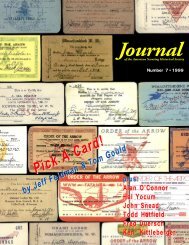Journal 6.PM - Gilwell.com!
Journal 6.PM - Gilwell.com!
Journal 6.PM - Gilwell.com!
You also want an ePaper? Increase the reach of your titles
YUMPU automatically turns print PDFs into web optimized ePapers that Google loves.
silk-screening). Presumably these were foran early non-OA camp society and it isbelieved other ranks existed. A red andgreen screened badge was also issued for“five year” campers.In 1956 Camp Aztec issued a triangularbadge with ac<strong>com</strong>panying 1956segment. Subsequent to the triangle CampAztec began issuing trapezoidal (Aztecpyramid) shaped badges. These trapezoidswere for wear both on hats and the Scoutshirts. The Trapezoid was issued on “notwill” and twill right (Fig. 5), as well asfully embroidered and stamped in leather(Fig. 4).Order of the ArrowBefore there was a Black EagleLodge, before there was a Hinode GoyaLodge there was Cuauhtli Lodge 446 inMexico, the first lodge outside of theUnited States and it’s territories (territoriallodges did exist prior in Alaska andthe Canal Zone). Cuauhtli signified theeagle in the Nahuatl Indian language.Cuauhtli Lodge never had more than thirtymembers. Tap outs and ceremonies startedsimple in the 1950’s (Fig. 6), but later, inFigure 7 – Cuauhtli Lodge used Aztecthemes for a ceremony at the 1969National Jamboree.years this badge was thought of as a fake,perhaps because of the number of themtraded over the years by Jay Knowles,sound evidence exists that the badge wasauthentic. For a number of years the sateenswere reissued within the lodge anda number from 1-4 was placed on the backto describe condition. Apparently whenthe badge was retired because of conditionor when the flap superceded it, Mr.Knowles, a badge trader in the 1950’s andwas issued to Ordeal honor members andthe solid was issued to Brotherhood honormembers. These flaps were issued afterthe lodge wasunder the Direct Serviceumbrella and are therefore consideredchapter badges by many collectors.The most mysterious badge issued bythe lodge was the flat chenille (C1) feltround (Fig. 9). This badge is misspelled(Cuautli) and was issued in the late 1950’sand early 1960’s. The badge was used forspecial recognition, such as for Vigil orspecial service to the council and was pri-Figure 9 – Official Cuauhtli Lodgepatches from the 1950’s; R1, C1,and F1.Figure 6 – Cuauhtli Lodge ceremony atCamp Aztec in the mid-1950’s.the 1960’s, took on a distinctive and mostimpressive Aztec theme (Figs. 7 and 8).The first badge of the lodge, the darkyellow sateen round with green silkscreeningwas issued circa 1952 (Fig. 9).The design incorporated the Mexican flag,which features an eagle with a snake inits beak except they replaced the snakewith an arrow sash. Although for manyFigure 8 – Cuauhtli Lodge ceremony atthe 1969 National Jamboree.1960’s, ended up with the supply of thebadges.In 1956 Cuauhtli Lodge issued its firstand only official flap (F1) (Fig. 9). Subsequentto the F1, rolled edge versions ofthe first flap were made (Fig. 10). The twillFigure 10 – Rolled-edge CuauhtliLodge flaps from the 1960’s wereissued after the lodge’s officialdisbandment and are usuallyconsidered to be unofficial issuesor chapter flaps of Lodge 555Gamenowiwink.<strong>Journal</strong> of The American Scouting Historical Society17



